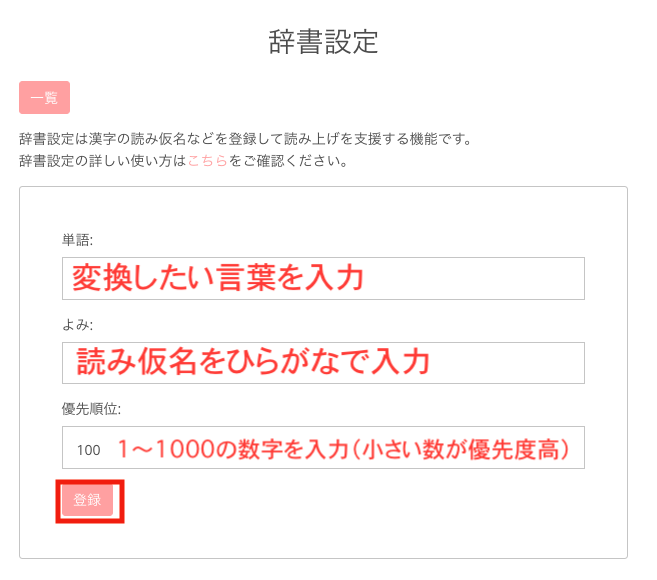A dictionary function is now available on Ondoku! Usage and details
June 20, 2025

Hello, this is Ondoku.
In fact, we made a big update on Ondoku last night. How many people have noticed?
Is there anything you will notice from now on?
Take a closer look at the Ondoku page.
The hint is the "menu bar".
...
Did you notice?
The correct answer is the addition of the " dictionary" function .

You can see that "Dictionary" is newly displayed in the menu bar.
The request "I want you to add a dictionary function", which I received several times from inquiries, has finally come to fruition. Everyone who made inquiries, thank you very much for your patience.
By the way , only those who are registered as members can use this function .
This time, I will introduce how to use this dictionary function and details.
How to use Ondoku's dictionary
Using the dictionary is very easy.
However, this function can only be used by registered members. Be sure to log in before using.
Register a new word

- Click on the dictionary in the menu bar
- Click the registration button on the dictionary page

- Enter the word you want to convert in the word field
- Enter the reading kana of the word you want to convert in the reading field in hiragana
- Enter the priority * The smaller the number, the higher the priority.
Change the priority when entering similar feelings or words. - Click Register when you can enter
This completes the new dictionary registration.
Edit the dictionary

- Click the dictionary on the menu bar
- Click Edit for the word you want to edit
- Correct the part you want to edit
- Click Register
This completes the dictionary editing.
What is the priority?
Set the priority with a number from 1 to 1000.
The lower the number, the higher the priority.
Example:
1 = 1 highest priority
2 = 2nd priority
3 = 3rd priority
Adjust this priority if the text-to-speech conversion does not work.
User dictionary function is essential for reading Japanese sentences

I will tell you a little difficult story.
Japanese kanji are ideographic characters . Hiragana and Katakana in Japanese are phonetic characters .
It is one of the rare languages in which Japanese phonetic characters and ideographic characters are mixed.
First,
What is an ideographic character?
One of the character classifications. A character in which each character has a certain meaning. Kanji and ancient Egyptian hieroglyphs. Character.
Source: goo dictionary
Therefore, even if the kanji is the same, there are many cases where the reading differs depending on the flow of sentences and phrases.
Example:
How to read "raw" is as follows.
Read aloud "Say" "Show"
Kun'yomi "Ikiru" "Ikasu" "Ike" "Umareru" "Umu" "Ou" "Haeru" "Hayasu" "Ki" "Nama"How to read "below" is as follows.
Read aloud "ka" "ge"
Kun'yomi "Shimo" "Moto" "Sageru" "Sagaru" "Kudaru" "Kusu" "Give me" "Grate" "Oriru"
Source: Kanji Dictionary
this is. It's a tremendous amount of work for text-to-speech software.
I predict it using algorithms to some extent and convert it to voice, but it is not perfect, so it can be wrong.
Romaji and other characters used in English are phonetic characters, not ideographic characters.
What is a phonetic character?
One of the character classifications. Characters that represent only sound, with each character having no meaning. Kana, Romaji, Sanskrit, etc. There are syllabaries and phoneme characters. Letters. Phonetic alphabet.
Source: goo dictionary
In the case of phonetic characters, the text-to-speech software only has to read it exactly as it is, so there is less trouble like in Japanese.
You can read it exactly as it is written, so there are almost no situations where you need a dictionary.
In a sense, Japanese is a language that makes sentence-reading software developers cry.
However, the dictionary function added this time must solve misreading and annoyance.
Please try using this convenient dictionary function!
This dictionary function is currently only available in Japanese. It cannot be used in other languages.
If you switch the language of the site display, the word dictionary disappears from the menu bar.
We are proud to continue to be the best text-to-speech software for you.
We look forward to your continued support of Ondoku .
■ AI voice synthesis software "Ondoku"
"Ondoku" is an online text-to-speech tool that can be used with no initial costs.
- Supports approximately 50 languages, including Japanese, English, Chinese, Korean, Spanish, French, and German
- Available from both PC and smartphone
- Suitable for business, education, entertainment, etc.
- No installation required, can be used immediately from your browser
- Supports reading from images
To use it, simply enter text or upload a file on the site. A natural-sounding audio file will be generated within seconds. You can use voice synthesis up to 5,000 characters for free, so please give it a try.
Email: ondoku3.com@gmail.com
"Ondoku" is a Text-to-Speech service that anyone can use for free without installation. If you register for free, you can get up to 5000 characters for free each month. Register now for free














